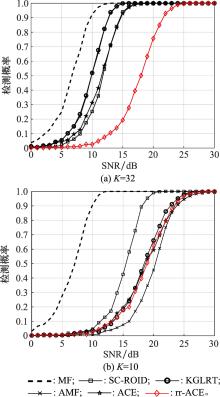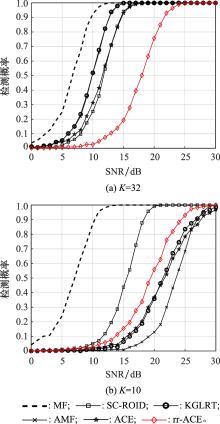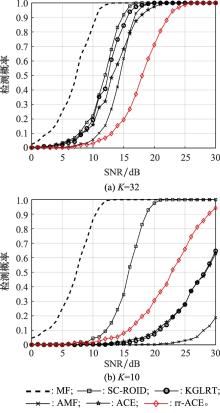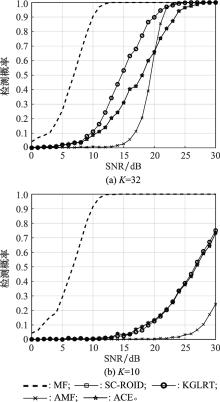| 1 |
DE MAIO A , GRECO M S . Modern radar detection theory[M]. Massachusets: Massachusets SciTech Publishing, 2016.
|
| 2 |
KELLY E J . An adaptive detection algorithm[J]. IEEE Trans.on Aerospace and Electronic System, 1986, 22 (1): 115- 127.
|
| 3 |
ROBEY F C , FUHRMANN D R , KELLY E J. , et al. A CFAR adaptive matched filter detector[J]. IEEE Trans.on Aerospace and Electronic System, 1992, 28 (1): 207- 216.
|
| 4 |
DE MAIO A , IOMMELLI S . Coincidence of the Rao test, Wald test, and GLRT in partially homogeneous environment[J]. IEEE Signal Process Letters, 2008, 15, 385- 388.
doi: 10.1109/LSP.2008.920016
|
| 5 |
DE MAIO A . Rao test for adaptive detection in Gaussian interference with unknown covariance matrix[J]. IEEE Trans.on Signal Processing, 2007, (55): 3577- 3584.
|
| 6 |
DE MAIO A . A new derivation of the adaptive matched filter[J]. IEEE Signal Processing Letters, 2004, 11, 792- 793.
doi: 10.1109/LSP.2004.835464
|
| 7 |
BESSON O , BIDON S . Adaptive processing with signal contaminated training samples[J]. IEEE Trans.on Signal Processing, 2013, 61 (7): 4318- 4329.
|
| 8 |
KRAUT S , SCHARF L L . The CFAR adaptive subspace detector is a scale-invariant GLRTs[J]. IEEE Trans.on Signal Processing, 1999, 47 (9): 2538- 2541.
doi: 10.1109/78.782198
|
| 9 |
BIDON S , BESSON O , TOURNERET J Y . The adaptive coherence estimator is the generalized likelihood ratio test for a class of heterogeneous environments[J]. IEEE Signal Processing, 2008, 15, 281- 284.
doi: 10.1109/LSP.2007.916044
|
| 10 |
BESSON O , ORLANDO D . Adaptive detection in nonhomogeneous environments using the generalized eigenrelation[J]. IEEE Signal Processing Letters, 2007, 14 (10): 731- 734.
doi: 10.1109/LSP.2007.898355
|
| 11 |
BESSON O , TOURNERET J Y , BIDON S . Knowledge-aided Bayesian detection in heterogeneous environments[J]. IEEE Signal Processing Letters, 2007, 14 (5): 355- 358.
doi: 10.1109/LSP.2006.888088
|
| 12 |
FENG D , XU L , PAN X , et al. Jamming wideband radar using interrupted-sampling repeater[J]. IEEE Trans.on Aerospace and Electronic System, 2017, 53 (3): 1341- 1354.
doi: 10.1109/TAES.2017.2670958
|
| 13 |
LIU W J , HAN H , LIU J , et al. Multichannel radar adaptive signal detection in interference and structure nonhomogeneity[J]. Science China Information Sciences, 2017, 60 (11): 112- 302.
|
| 14 |
BESSON O. Detection in the presence of surprise or undernulled interference[J]. IEEE Signal Processing Letters, 14(5): 352-354.
|
| 15 |
ADDABBO P , BESSON O , ORLANDO D , et al. Adaptive detection of coherent radar targets in the presence of noise jamming[J]. IEEE Trans.on Signal Processing, 2019, 67 (24): 6498- 6510.
doi: 10.1109/TSP.2019.2954499
|
| 16 |
WANG Z . Adaptive detection of a subspace signal in Gaussian noise and rank-one interference[J]. Digital Signal Processing, 2020, 96, 111- 222.
|
| 17 |
BESSON O, CHAUMETTE E, VINCENT F. Adaptive detection of a Gaussian signal in Gaussian noise[C]//Proc. of the 6th IEEE International Workshop on Computer Advances Multi-Sensor Adaptive Processings, 2015: 117-120.
|
| 18 |
COLUCCIA A , RICCI G , BESSON O . Design of robust radar detectors through random perturbation of the target signature[J]. IEEE Trans.on Signal Processing, 2019, 67 (19): 5118- 5129.
doi: 10.1109/TSP.2019.2935915
|
| 19 |
ORLANDO D . A novel noise jamming detection algorithm for radar applications[J]. IEEE Trans.on Signal Processing, 2017, 24 (2): 206- 210.
doi: 10.1109/LSP.2016.2645793
|
| 20 |
邹鲲, 廖桂生, 李军, 等. 非高斯杂波下知识辅助检测的认知方法[J]. 电子学报, 2014, 42 (6): 1047- 1054.
doi: 10.3969/j.issn.0372-2112.2014.06.002
|
|
ZOU K , LIAO G S , LI J , et al. Cognitive method for knowledge aided detection in non-Gaussian clutter[J]. Acta Electronica Sinica, 2014, 42 (6): 1047- 1054.
doi: 10.3969/j.issn.0372-2112.2014.06.002
|







